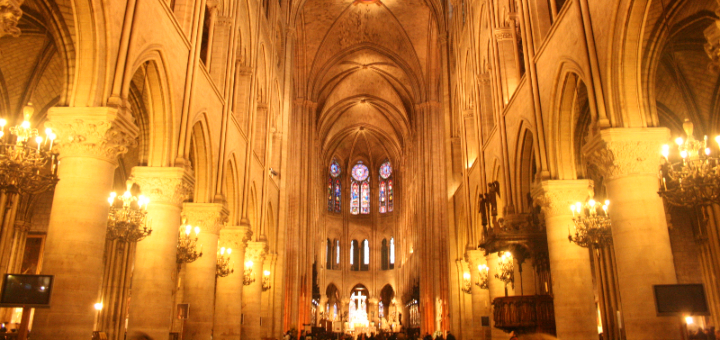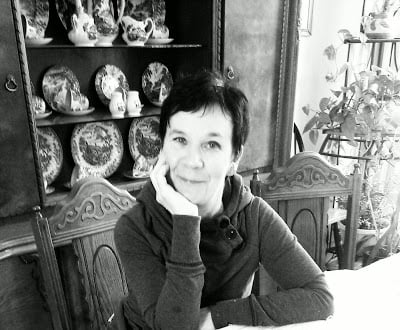
 Diego Delso [CC BY 3.0], via Wikimedia Commons[/caption]The first time I walked into a Catholic church as a Protestant child, I was hit by a sense of a Holy Presence. Overwhelmed by awe, I tiptoed around this foreign church. The whole atmosphere seemed exotic, with dim, soft lighting coming through gorgeous stained-glass windows and a few votive candles. Incense assaulted my nostrils, countless paintings and statues begged for my visual attention and the holy water in the font felt holy.
This encounter was an experience of both sensory and spiritual overload, a profound experience of the Holy. God touched that little child's inner spiritual self through her physical senses. As a child, I could not yet articulate an explanation. Now I understand that the art, sculpture, water, and incense are sacramentals, physical objects infused by the Holy Spirit, imbued with the Divine.
Contrast this rich atmosphere with the stark place of worship of my childhood in the Presbyterian church. Plain white walls were broken only by a single bare wooden cross at the front of the sanctuary. The pews were low backed and unadorned. The lighting was bright, almost harsh with plain glass windows. A durable, light beige rug covered the floor. One small cloth, featuring the burning bush, hung over the minister's pulpit. The decorating was bland, at best.
My childhood experience of church was the result of the Protestant Reformation which emphasized preaching as the main vehicle for evangelizing and the formation of believers; they believed that "faith comes from hearing" (Romans 10:17). All other senses, except hearing, were considered a distraction from God during a service.
Contrary to this Puritanical view is the Catholic understanding that all five senses are vehicles to apprehend Divine reality. The Bible itself tells us to "taste and see that the Lord is good" (Psalm 34:9, 1 Peter 2:3) and Isaiah says, "hear the word of the Lord." Jesus promises that "the pure in heart will see God" (Matthew 5:8) and that the faithful will "inhale the sweet aroma of Christ" (2 Corinthians 2:15). St. Paul blessed handkerchiefs to be placed on those needing healing who lived far away. Even Christ himself spat on the ground, made mud and placed it on the blind man's eyes because He understood the power of touch.
The Church understands the power of the Sacraments with their physical signs; sometimes man needs the touch of holy water or blessed oil as well as hearing prayers to open his soul to the power of Christ. God knows that we are body and spirit. Obviously, the physical sense of taste is directly related to an encounter with the Mystical Body of Christ in the Eucharist. Jesus commanded us to "Take, eat, for this is My Body given for you." Jesus did not want us to simply watch the priest during the Consecration. It is not enough to just hear the words of the Last Supper; we must actively participate with our bodies by tasting and eating, taking the host into our physical bodies. This physical action of eating is the doorway to a spiritual encounter, real union with the Mystical Body of Christ.
A holy person is not someone who disdains his body, like the impression given by old holy cards where a sickly, pasty-faced saint with eyes rolled back in his head gazes heavenward while looking like a stiff breeze will knock him over. No, a holy person is one who has achieved harmony between his body and spirit and the Spirit of God because we perceive the Divine and communicate with God as beings who possess both physical and spiritual senses. The Catholic Church understands that believers come to a fuller sense of Christ through the totality of their human person.
Diego Delso [CC BY 3.0], via Wikimedia Commons[/caption]The first time I walked into a Catholic church as a Protestant child, I was hit by a sense of a Holy Presence. Overwhelmed by awe, I tiptoed around this foreign church. The whole atmosphere seemed exotic, with dim, soft lighting coming through gorgeous stained-glass windows and a few votive candles. Incense assaulted my nostrils, countless paintings and statues begged for my visual attention and the holy water in the font felt holy.
This encounter was an experience of both sensory and spiritual overload, a profound experience of the Holy. God touched that little child's inner spiritual self through her physical senses. As a child, I could not yet articulate an explanation. Now I understand that the art, sculpture, water, and incense are sacramentals, physical objects infused by the Holy Spirit, imbued with the Divine.
Contrast this rich atmosphere with the stark place of worship of my childhood in the Presbyterian church. Plain white walls were broken only by a single bare wooden cross at the front of the sanctuary. The pews were low backed and unadorned. The lighting was bright, almost harsh with plain glass windows. A durable, light beige rug covered the floor. One small cloth, featuring the burning bush, hung over the minister's pulpit. The decorating was bland, at best.
My childhood experience of church was the result of the Protestant Reformation which emphasized preaching as the main vehicle for evangelizing and the formation of believers; they believed that "faith comes from hearing" (Romans 10:17). All other senses, except hearing, were considered a distraction from God during a service.
Contrary to this Puritanical view is the Catholic understanding that all five senses are vehicles to apprehend Divine reality. The Bible itself tells us to "taste and see that the Lord is good" (Psalm 34:9, 1 Peter 2:3) and Isaiah says, "hear the word of the Lord." Jesus promises that "the pure in heart will see God" (Matthew 5:8) and that the faithful will "inhale the sweet aroma of Christ" (2 Corinthians 2:15). St. Paul blessed handkerchiefs to be placed on those needing healing who lived far away. Even Christ himself spat on the ground, made mud and placed it on the blind man's eyes because He understood the power of touch.
The Church understands the power of the Sacraments with their physical signs; sometimes man needs the touch of holy water or blessed oil as well as hearing prayers to open his soul to the power of Christ. God knows that we are body and spirit. Obviously, the physical sense of taste is directly related to an encounter with the Mystical Body of Christ in the Eucharist. Jesus commanded us to "Take, eat, for this is My Body given for you." Jesus did not want us to simply watch the priest during the Consecration. It is not enough to just hear the words of the Last Supper; we must actively participate with our bodies by tasting and eating, taking the host into our physical bodies. This physical action of eating is the doorway to a spiritual encounter, real union with the Mystical Body of Christ.
A holy person is not someone who disdains his body, like the impression given by old holy cards where a sickly, pasty-faced saint with eyes rolled back in his head gazes heavenward while looking like a stiff breeze will knock him over. No, a holy person is one who has achieved harmony between his body and spirit and the Spirit of God because we perceive the Divine and communicate with God as beings who possess both physical and spiritual senses. The Catholic Church understands that believers come to a fuller sense of Christ through the totality of their human person.
Copyright 2019 Melanie Jean Juneau
About the Author

Melanie Jean Juneau
Melanie Jean Juneau is a mother of nine children who blogs at joy of nine9. Her writing is humorous and heart-warming; thoughtful and thought-provoking. Part of her call and her witness is to write the truth about children, family, marriage and the sacredness of life. Melanie is the administrator of ACWB, the Editor in Chief at CatholicLane, CatholicStand, Catholic365 , CAPC & author of Echoes of the Divine.


.png?width=1806&height=731&name=CatholicMom_hcfm_logo1_pos_871c_2728c%20(002).png)
Comments